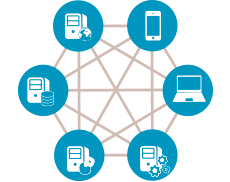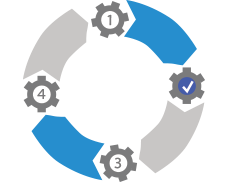It seems that you cannot read an article or marketing collateral for an IT product or service that’s not claiming to enable or power digital transformation (DX). The term “digital transformation” is overused and irrelevant.
I spoke on this topic at a previous Red Hat Partner Conference where Vizuri won their first Partner of Excellence award. As Channelnomics captured in my address, throwing around the term as a popular catchphrase helps no one understand the real meaning of using emerging technologies and modern software architectures. I’d like to revisit my remarks and the caveats I spoke on. I believe that DX is so widely overused that it’s “Jumped the Shark.”
 Fonzie jumps over a shark enclosure in Happy Days. Having worn out its welcome, the show employed gimmicks like this to grab viewer interest. Similarly, "digital transformation" has worn out its welcome and has jumped the shark.
Fonzie jumps over a shark enclosure in Happy Days. Having worn out its welcome, the show employed gimmicks like this to grab viewer interest. Similarly, "digital transformation" has worn out its welcome and has jumped the shark.
Service-oriented design continues to evolve with the advent of next-generation architectures that are based on microservices and Linux-based containers. Our strategy in IT has and should continue to be a focus on continuous levels of process improvement (e.g. software design, architecture, integration, computation), refinement, and simplified maturity, not complexity. As Jason Bloomberg writes for Forbes, digital transformation is “a never-ending journey to establishing change itself as a core competency across the organization."
How Do We Define Digital Transformation?
I speak regularly about digital transformation from a software engineering and business solutions perspective. Before I receive a multitude of feedback from other IT providers, I will limit my definition of digital transformation to the digitization of processes within a business perspective, which may or may not include technology. In doing so, I would like to reference the digital transformation definition from a 2014 MIT Sloan article, where they describe digital transformation as:
“The use of technology to radically improve performance or reach of enterprises to change customer relationships, internal processes and value propositions.”
To summarize, digital transformation is a business strategy, not a technology. In light of that definition, three key areas for transformation include customer understanding, customer touch points, and process digitization.
Customer Understanding
Businesses are transforming to gain a better understanding of their customers within:
- Specific Geographies – Where are their products/services performing well or needing improvement?
- Market Segments – Which market segments are underserved and could be expanded into or grown?
- Lifestyle and Consumer Behaviors – What consumer lifestyle segments or behaviors can be addressed through process digitization?
Customer Touch Points
Organizations need to provide means and mechanisms for interacting and communicating with their customers and are transforming to gain a better understanding and serve their customers within:
- Multiple Communication Channels – Customers are interacting through more than one communication channel (e.g. mobile, web, brick-and-mortar).
- Integration Across Internal and External Processes – Organizations are creating seamless process flows and transactions to serve their customers through electronically integrating customers and trading partners. This simplifies and standardizes intercommunication to provide scale and efficiency.
- Interacting With Customers on Their Preferred Device – Customers now have the choice of which device they use (e.g. browser, native mobile application) and how they wish to engage with an organization.
Process Digitization
Process digitization is nothing new to IT. Organizations have been digitizing manual processes for several decades and there are several everyday use cases that everyone can relate to, including automated and online banking operations (e.g. mobile deposit, bill pay, cash withdrawal) and airline travel (e.g. reservation, ticketing, boarding passes, security). Process digitization aims at providing seamless transactions across multiple trading partners to deliver a holistic mobile, social, and interconnected experience.
Vizuri’s Pillars of Transformation
We believe that transformation can be broken down into three pillars: infrastructure, integration, and knowledge. Many technologies can be grouped under each of the pillars that account for the traditional computation, storage, and network products, but we’ll focus on these three areas.
Infrastructure Management
 In your modernization efforts, the target state should provide a robust, flexible and reliable infrastructure that can respond quickly to changing customer needs. A long-term goal should be to develop a programmable way to provision, deploy, and decommission infrastructure and applications resources in a myriad of environments. Focus areas include:
In your modernization efforts, the target state should provide a robust, flexible and reliable infrastructure that can respond quickly to changing customer needs. A long-term goal should be to develop a programmable way to provision, deploy, and decommission infrastructure and applications resources in a myriad of environments. Focus areas include:
- CI/CD pipelines
- Containers
- Automation provisioning
- Self-service
- Governance
- Cloud deployment models – On-Premise/Hybrid/Multi
Expertise in cloud deployment: We have found that many organizations underestimate their skills gap and run into many application performance and operational stability issues. Official training is key and essential to avoid the pitfalls.
Integration Management
 An organization cannot be all things to all people, but requires partnerships and coordinated business transactions to compete and be a leader in the digital economy. To compete in today’s digital economy, businesses require tightly integrated supply chains and service providers. We previously used web services to expose service-based integrations, but a more modern approach is the creation of microservices that are exposed and governed by an API gateway. Focus areas include:
An organization cannot be all things to all people, but requires partnerships and coordinated business transactions to compete and be a leader in the digital economy. To compete in today’s digital economy, businesses require tightly integrated supply chains and service providers. We previously used web services to expose service-based integrations, but a more modern approach is the creation of microservices that are exposed and governed by an API gateway. Focus areas include:
- Microservice architecture
- API gateway for third-party and internal transactions
- Security
- Monetization
- “Death Star” architectures
Watch out for the "Death Star": We have found that many organizations define their services at a too-granular level, which leads to hundreds of small services that are hard to understand and create an unnecessary amount of noise. Their architectural diagrams look like the “Death Star” from Star Wars. Using an API microservice approach for both internal and external communications provides an abstraction layer where the implementation is separated from the interface and true agility can occur because the underlying implementation can change without affecting operations.
Knowledge Management
 “Knowledge Management is the process of capturing, distributing, and effectively using knowledge. It is a discipline that promotes an integrated approach to identifying, capturing, evaluating, retrieving, and sharing all of an enterprise's information assets. These assets may include databases, documents, policies, procedures, and previously un-captured expertise and experience in individual workers.”
“Knowledge Management is the process of capturing, distributing, and effectively using knowledge. It is a discipline that promotes an integrated approach to identifying, capturing, evaluating, retrieving, and sharing all of an enterprise's information assets. These assets may include databases, documents, policies, procedures, and previously un-captured expertise and experience in individual workers.”
Many organizations bury critical business rules, decisions and conditional logic within application software code, database stored procedures and packages, and within undocumented scripts and human procedures (i.e. Tribal Knowledge). While every organization is trying to attain business agility, they are anchored by the technical debt they have created. Extracting knowledge and providing it in a way that is easy to consume and provides a “single source of truth” requires thinking differently and using business process and rules technologies. Focus areas include:
- Business rules/decision logic
- Business processes
- Predictive analytics
- Machine learning
- Unprecedented amounts of data
A cautionary tale: Data is not an implementable focus area; leveraging historical knowledge places a financial burden on any organization. They have to determine how much information is enough to evaluate their rules and make informed decisions. We have implemented more than 20 business rules and process engagements over the last three years. We have seen the benefits of moving to a knowledge management framework. We have shortened insurance underwriting process by as much as 65% and improved the claims settlement and adjudication process by leveraging business process management and rules technologies.
Modern Software Architecture
Technology is not a panacea. It is a tool, not a solution. How you design your solutions architecturally is critical to realizing your transformation goals. There are numerous mainstream technologies that, when properly aligned, do provide the business agility that organizations are looking to achieve. In addition, there are several emerging technologies that do require research and assimilation, once proven.
Mainstream Technologies
- Application programming interfaces (APIs)
- Microservices and enterprise messaging
- Business process and rule management
- CI/CD, DevOps automation
- Container management and orchestration
Emerging and Experimental Technologies
- Blockchain
- Artificial intelligence
- Apache Spark: Cluster computing
- IoT
If you are interested in learning more about knowledge management, please read “The Knowledge Engineer – The New Sheriff in Town” and subscribe to our blog for our upcoming content on modern solution architectures.






